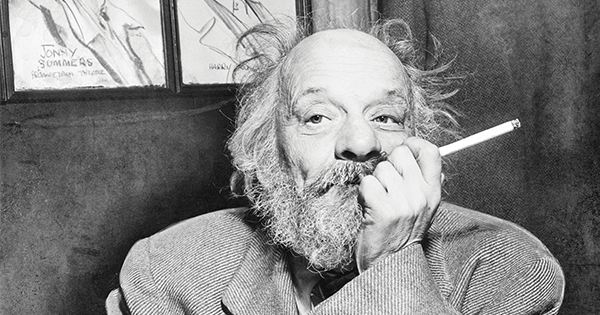
Joe Gould’s Teeth by Jill Lepore; Knopf, 235 pp., $24.95
In 1942, Joseph Mitchell, master of the magazine profile, introduced the world to a “blithe and emaciated little man” named Joe Gould in the pages of The New Yorker. Mitchell’s article, “Professor Sea Gull,” presents Gould as a near-comic figure who had attended Harvard and studied eugenics, befriended the great literary lions of his age, and was at work—always at work—on “An Oral History of Our Time,” an immense, shapeless, and haphazard collection of character portraits and conversations of ordinary people, the pages of which he wrote and kept hidden in countless locations.
The piece made Gould, ever penniless and drunk, into a celebrity and cemented Mitchell’s literary fame. But in 1964, in a two-part sequel titled “Joe Gould’s Secret,” Mitchell revealed what he believed to be the truth about Gould: his oral history had never existed, at least not on paper. Mitchell surmised that Gould, who had died in a state psychiatric facility in 1957, had gotten stuck somehow and kept all of the information he collected in his head. As it happens, Mitchell himself soon fell into a similar trap: after finishing his second profile of Gould, he continued to work at The New Yorker for another 30 years but never published another word.
Now, almost 60 years after Gould’s death, Harvard professor and New Yorker staff writer Jill Lepore tries once and for all to unravel the mystery—did Gould’s oral history ever exist? She first tackled the question in The New Yorker in July 2015 and now elaborates on her answer in a slight volume by the same name as the article, Joe Gould’s Teeth (all of which were likely removed upon his admission to a mental hospital, in accordance with the then-prevailing scientific wisdom that “physical infections”—including rotten teeth—directly correlated to the patient’s mental state). It is at once a search for Gould’s writings, a hunt for the truth about the man himself, and a searing study of Mitchell’s journalistic ethics. In the end, though, the book almost inevitably mirrors the randomness that defined Gould’s life and work.
To be fair, we learn much from Lepore. Mitchell’s Gould was tormented and tiresome, a lush and a scoundrel, but also colorful, even harmless. But in her research, Lepore finds a man far darker than the one we thought we knew. The son of an old New England family, Gould struggled with mental illness from a young age and near the end of his life most likely received a partial lobotomy. He never finished Harvard. Yes, he enjoyed friendships with luminaries like Malcolm Cowley, e. e. cummings, John Dos Passos, and Ezra Pound. But he could be terribly cruel, especially toward women.
Most troubling are Gould’s menacing obsessions, which never found their way into Mitchell’s work. Foremost among them was Augusta Savage, an African-American sculptor of the Harlem Renaissance who spent years trying to avoid Gould. He stalked her relentlessly and, Lepore suggests, may have even raped her. Savage deserves more of Lepore’s attention—and that of serious scholars of art. At one time, critics lauded Savage’s talent, and she found fame (and escape from Gould) in Paris. But eventually, she stopped working and moved to a farm in New York State without running water or electricity. She died there in obscurity.
Then there is Mitchell, whose journalistic transgressions are by now well known—he invented at least two of his subjects. But Gould did exist, though perhaps not in the way Mitchell would have preferred. Lepore writes that Gould’s literary supporters had been pushing for a profile of him to appear in the magazine. Mitchell knew early on of Gould’s mental illness but made no mention of it. Mitchell later insisted that he tried his best to help Gould, but in Lepore’s portrayal, he comes off as unfeeling.
Mitchell wasn’t nearly the champion of Gould he presented himself to be. He declined to speak at Gould’s funeral, and following the publication of “Joe Gould’s Secret,” Lepore reveals, Mitchell heard from a number of people who claimed to have read parts of the oral history, and one sent him an excerpt from it. Mitchell never acknowledged this in print.
Lepore deserves credit for taking on the legend surrounding Gould and his oral history. Her prose is wonderful, her research unassailable. Although Mitchell wrote that Gould never produced anything close to what he claimed, Lepore locates the notebook Mitchell himself received in the mail after the publication of his 1964 pieces: it includes “snatches of conversation.” In the end, she finds only scraps of the great work, which Gould may well have written and destroyed over and over again. Yet Lepore succeeds in one crucial respect: she shows us the true Joe Gould rather than the one so many people wanted him to be.

